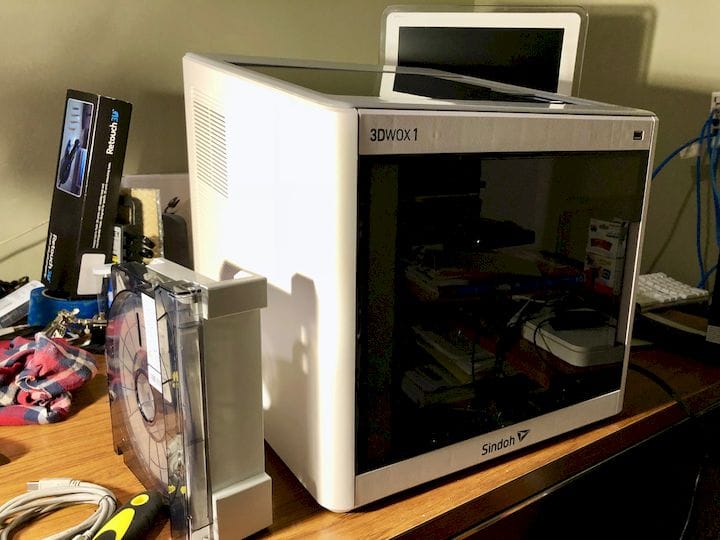![The 3Dwox 1 from Sindoh: a harbinger of the future? [Source: Fabbaloo]](https://fabbaloo.com/wp-content/uploads/2020/05/image-asset_img_5eb0961ca91d9.jpg)
After a discussion with Sindoh representatives, it seems the company may be changing their strategy regarding materials.
If you’re not familiar with Sindoh, they are a rather large South Korean company that is one of the world’s largest manufacturers of photocopiers and 2D paper printers. A few years ago they added a 3D printing strategy and launched the DP200, which was very well received. But it did not include an open materials strategy.
Why so? It was because they naturally brought forward their photocopier experience to the 3D printing table. Their first 3D printer, the DP200, offered a genuinely easy-to-use interface, which unsurprisingly felt a lot like using a photocopier. Photocopiers are used by tens of millions of people worldwide, and there have been decades of experience gradually working the interface into something easily understandable.
Thus their initial machine found itself more-or-less alone in the 3D printer market offering a simple touchscreen interface. At the time most desktop 3D printers were dominated by small rudimentary LCD panels offering an interface style only hardcore techies would appreciate.
Along with the interface expertise brought from the 2D world came their strategy for use of proprietary materials. The DP200 and several succeeding machines from Sindoh required the use of specialized filament cartridges. These cartridges were equipped with chips that would be read by the printer before use.
![A materials cartridge for use on the 3Dwox 1 [Source: Fabbaloo]](https://fabbaloo.com/wp-content/uploads/2020/05/image-asset_img_5eb0961d08fad.jpg)
Proprietary Material Advantages and Disadvantages
This did offer several advantages:
-
The printer could “know” how much filament remained on the spool and take appropriate actions
-
The print parameters could be very finely tuned to achieve high-quality, reliable printing
But there were some disadvantages:
-
The proprietary cartridges were harder to source than obtaining alternative generic filaments
-
The choice of material types and filament colors is quite limited
To Sindoh’s credit, they wisely did not use their proprietary position to gouge their customers on the price of material. In fact, these cartridges were (and are still) available at very reasonable pricing, comparable to any other filament choices.
But over time, it seems the company is slowly changing their thinking on this issue.
![The fabulous removable print bed on the 3Dwox 1 [Source: Fabbaloo]](https://fabbaloo.com/wp-content/uploads/2020/05/image-asset_img_5eb0961d6071c.jpg)
Open Materials 3D Printer
The first signal was their announcement of their latest and flagship desktop 3D printer, the 3Dwox 1, which we extensively reviewed last year. This machine introduce several new features, including one of the best removable print surfaces we’ve yet seen. But the major feature was the ability to use generic filament materials.
![A spool of generic filament installed in the 3Dwox 1 [Source: Fabbaloo]](https://fabbaloo.com/wp-content/uploads/2020/05/3dwox-1-open-spool-128129_img_5eb0961da0fc2.jpg)
Yes, the 3Dwox 1 can still accept proprietary filament cartridges, but in a special mode it can accept pretty much any spool, so long as it physically fits within the 3Dwox 1’s cartridge space. This allows 3Dwox 1 operators to easily 3D print in many materials well beyond the choices offered by their proprietary set of materials.
Discussions with Sindoh representatives recently revealed their thinking on this matter is switching to a more open stance. They now believe that they know 3D printers, but others know materials.
And this is very true, particularly recently when an explosion of new and unusual materials has emerged. These new materials attempt to address a myriad of requirements from new and existing 3D print operators worldwide. There has never been a better moment to choose a 3D print material — until tomorrow.
3D Print Material Profiles
Making these new, powerful and incredibly precise materials is a challenging prospect requiring significant dedicated expertise. That’s now clearly the realm of materials companies, and particularly true with the recent arrival of the major chemical companies on the scene.
Sindoh appears to be planning for this new world of generic materials by working on some type of material profile system yet to be released. We know no details of this potential system, other than it could enable a future Sindoh 3D printer operator to access printing parameters that are close to what is required for a successful print.
I have a suspicion Sindoh’s future 3D printers may always include open materials capability, as well as partnerships with different materials manufacturers.
Via Sindoh











An inventive designer has developed a method for producing 3D paper objects using recycled paper and 3D printed molds.